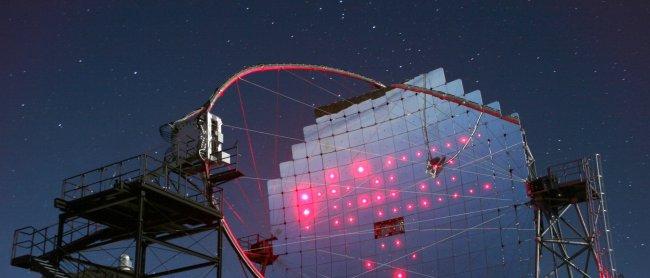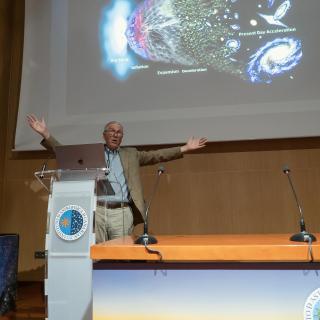An international team of scientists has managed to identify the origin of a neutrino, combining a signal detected by the IceCube experiment in Antartica with measurements by the Fermi-LAt satellite, and the MAGIC telescopes, as well as other instruments around the world. It is highly probable that the neutrino originated in an active black hole at the centre of a distant galaxy, a “blazar” in the direction of the constellation of Orion. This observation, termed “mutlimessenger” could also give us clues towards resolving the mystery of the origin of cosmic rays.
Neutrinos are elementary particles that barely interact with their surroundings. Although they are, for that reason, very difficult to detect, they are important cosmic messengers, because they carry exceptional information about the regions where they are produced.The biggest detector designed to capture these elusive particles is IceCube. On 22nd September 2017 IceCube detected a very special neutrino: its high energy (some 290 billion electron volts) showed that it could have been emitted by a very distant object. But in addition the observers were able to determine its arrival dirección with high accuracy.
Razmik Miroyan, spokesperson for the MAGIC collaboration, a scientist at the Max Planck Institute for Physics in Munich explains that “Theory predicts that the emission of neutrinos should be accompanied by the emission of light particles, or photons, and these can be detected by ordinary telescopes” That is why an alert triggered by the detection of the neutrino was sent to many instruments in the hope that their observations could discover the source of the particle.
Fermi-LAT, a satellite observatory which can study the whole sky, communicated that the direction of arrival of the neutrino was aligned with a source of gamma rays (high energy photons) at a distance of 4500 million light years from the Earth: the blazar TXS0506+056, an active galactic nucleus with a suprmassive black hole, which emits “jlets” a beam of particles travelling at almost the speed of light, together with radiation.
Observations with MAGIC, two telescopes of 17 metre diameter which detect high energy gamma rays from the Roque de los Muchachos Observatory (Garafía, La Palma) discovered that the radiation from the blazar reaches energies of at least 500 billion electron volts. These observations, combined with the direction of the neutrino found in IceCube, make the blazar a probable candidate for a neutrino source.
Other "conventional" telescopes also tried to observe the source of the event in order to find out the distance. However, the signal was so faint that only the observations made with the Gran Telescopio Canarias (GTC), the largest optical-infrared telescope in the world located in the observatory of the Instituto de Astrofísica de Canarias (IAC) in La Palma, made it possible to detect the typical features of the galaxy's gas emission, and thus to determine its distance.
A tracer of cosmic rays
As the production of neutrinos is associated with interactions of protons, the observations could also help to solve an old mystery: the origin of cosmic rays, identified by Domenico Pacini in 1911 and verified by Victor Hess in 1912. Cosmic rays are mostly high energy protons.
As explained by Elisa Bernardini, principal investigator of the project on MAGIC, who is a researcher at DESY, Zeuthen, and at the Humboldt University in Berlin, the reason why it is so difficult to find the sources of cosmic rays is that “protons, which have a positive electric charge, are deviated by magnetic fields in space, so that because they do not travel in a straight line, we cannot see the direction from which they have come”.
On the other hand neutrinos and photons, which do not have electric charge, travel through space without deviation. This allows us to identify the astrophysical objects which produce them. “The cosmic neutrino tells us that the blazar is capable of accelerating protons to very high energies, and therefore may be a source of cosmic rays” adds Bernardini.
Products of protons in the jet
Once the source was identified, the MAGIC telescopes continued observing the blazar for 41 hours, and obtained additional information aboujt the intrinsic processes within the source. “ “The results confirm that, as well as the neutrino, the gamma rays are partly produced by high energy protons in the jet” explains Mirzoyan “ so that this is the first time that we can confirm that the neutrinos and the gamma rays have the same progenitor, the proton”.
The researchers also found a very clear clue within the spectrum of the high energy gamma rays from the blazar “We see a loss of photons in a certain range of energies” says Bernardini “which implies that the neutrino in IceCube could have been produced by the interaction of protons with photons within the blazar’s jet”. These results have just been published in the journal “Astrophysical Journal Letters” “They corroborate a genuine connection between the differnt messengers formed by the different particles: the neutrino and the photons” comments Mirzoyan.
MAGIC and multimessenger astronomy
María Victoria Fonseca, Chair of the Board of the MAGIC collaboration, and Professor at the Complutense University of Madrid (UCM) considers that “This pioneer work, coordinating observation techniques which are very different and spread around the world, to look at the most extreme places in the universe, opens a new era in the detection of cosmic messengers, giving us a new view of the cosmos.
Manel Martínez, Chair of the Time Allocation Committe for MAGIC and a researcher at the Insttitute for High Energy Physics (IFAE) in Barcelona, points out the high priority for this type of alerts, and add that “with these observations MAGIC is now making a decisive contribution to the opening of new windows on the universe”.
The Spanish scientific community has been participating in MAGIC since its inception through a number of public research centres, among them the Instituto de Atrofísica de Canarias (IAC) the Institute of High Energy Physics (IFAE) the Autonomous University of Barcelona (UAB) the University of Barcelona (UB) and the Complutense University of Madrid (UCM). In addition the data centre for MAGIC is the Port dÌOnformació Científica (PIC) a collaboration between the IFAE and the Centre for investigation in Energy, the Environment, and Technology (CIEMAT).
Scientific article: The IceCube Collaboration et al. Multimessenger observations of a flaring blazar coincident with high-energy neutrino IceCube-170922A. Science, Vol. 361, Issue 6398, 13 Jul 2018. DOI: 10.1126/science.aat1378 http://science.sciencemag.org/content/361/6398/eaat1378
Related news: GTC studies the origin of the neutrino detected in the “Ice Cube” in the South Pole
Direct broadcast of the press conference:
youtube.com/c/VideosatNSF/live
Contact:
Razmik Mirzoyan
MAGIC spokesperson
Max Planck Institute for Physics
Razmik.Mirzoyan [at] mpp.mpg.de (Razmik[dot]Mirzoyan[at]mpp[dot]mpg[dot]de)
Elisa Bernardini
DESY Zeuthen and Humboldt University
Elisa.Bernardini [at] desy.de (Elisa[dot]Bernardini[at]desy[dot]de)
Oscar Blanch
MAGIC Outreach Manager
IFAE, Barcelona, España
blanch [at] ifae.es (blanch[at]ifae[dot]es)
+34-662-121-243



